Island Stories:
![]() Danzig
Mine
Danzig
Mine
![]() Zeballos
Iron Mine
Zeballos
Iron Mine
![]() Conuma
Peak 1910
Conuma
Peak 1910
Alexandra Peak
Argus Mountain
Bate/Alava Sanctuary
Beaufort Range
Big Interior Mtn
Big Interior Mtn 1913
Part 1
Part 2
Bolton Expedition 1896
Cliffe Glacier
Clinton Wood
Comox Glacier
Comox Glacier 1922
Comox Glacier 1925
Comstock Mtn
Conuma Peak
Copper King Mine
Crown Mtn
Elkhorn 1912
Elkhorn 1949
Elkhorn 1968
Eugene Croteau
Golden Bullets
Golden Hinde 1913/14
Golden Hinde 1937
Golden Hinde 1983
Harry Winstone Tragedy
Jack Mitchell
Jim Mitchell Tragedy
John Buttle
Judges Route
Koksilah's Silver Mine
Landslide Lake
Mackenzie Range
Malaspina Peak
Mariner Mtn
Marjories Load
Matchlee Mountain
Mount McQuillan
Mt. Albert Edward
Mt. Albert Edward 1927
Mt. Albert Edward 1938
Mt. Becher
Mt. Benson 1913
Mt. Benson
Mt. Doogie Dowler
Mt. Colonel Foster
Mt. Hayes/Thistle Claim
Mt. Maxwell
Mt. Sicker
Mt. Tzouhalem
Mt. Whymper
Muqin/Brooks Peninsula
Nine Peaks
Queneesh
Ralph Rosseau 1947
Rosseau Chalet
Ralph Rosseau Tragedy
Rambler Peak
Red Pillar
Rex Gibson Tragedy
Sid's Cabin
Steamboat Mtn
Strathcona Park 1980's
The Misthorns
The Unwild Side
Victoria Peak
Waterloo Mountain 1865
Wheaton Hut/Marble Meadows
William DeVoe
Woss Lake
You Creek Mine
Zeballos Peak
Other Stories:
Sierra
de los Tuxtlas
Antarctica
Cerro del Tepozteco
Citlaltepetl
Huascaran
Mt. Roraima
Nevada Alpamayo
Nevada del Tolima
Nevado de Toluca
Pico Bolivar
Popocatepetl
Uluru/Ayers Rock
Volcan Purace
Volcan San Jose
Biographies
Island 6000
Cartoons
Order the Book
Contact Me
Links

Malaspina
Peak:
The
Nootka Connection
by Lindsay Elms
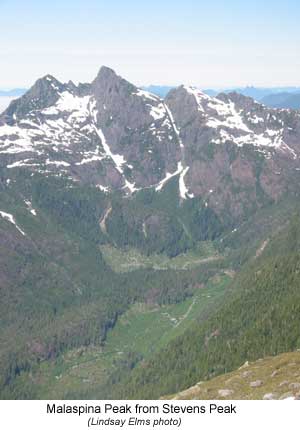 Guarding
the entrance to the Mount Bate and Alava sanctuary from the southwest
above Perry Creek is the impressive twin summited mountain called Malaspina
Peak (1,573m.) In the winter, from the gravel road that links the logging
town of Tahsis to the booming tourist and salmon fishing centre of Gold
River, countless waterfalls cascade off the surrounding rock walls while
in summer water drips from the moss left clinging to the near vertical
rock faces. Although rarely climbed this peak has a unique link to the
history of Canada's west coast as it honours Captain Alejandro Malaspina,
a celebrated Italian seaman in the naval services of Spain.
Guarding
the entrance to the Mount Bate and Alava sanctuary from the southwest
above Perry Creek is the impressive twin summited mountain called Malaspina
Peak (1,573m.) In the winter, from the gravel road that links the logging
town of Tahsis to the booming tourist and salmon fishing centre of Gold
River, countless waterfalls cascade off the surrounding rock walls while
in summer water drips from the moss left clinging to the near vertical
rock faces. Although rarely climbed this peak has a unique link to the
history of Canada's west coast as it honours Captain Alejandro Malaspina,
a celebrated Italian seaman in the naval services of Spain.
Alejandro Malaspina was born on November 5, 1754, to an aristocratic and distinguished Italian family in Mulazzo, in northern Tuscany. After studying at the Clementine College in Rome, he learned navigation as a Knight of the Order of Malta, and worked his way up to the rank of Captain in the Spanish Navy.
In the specially constructed ships Descubierta (Discovery) and Atrevida (Daring or Bold), he set sail in 1789 on a political and scientific voyage around the Pacific. In 1791 the King of Spain ordered Malaspina to search for a Northwest Passage but after examining the Alaska coast as far west as Prince William Sound he returned to Nootka Sound where he spent about a month at the Spanish outpost on the west coast of Vancouver Island before returning to Mexico. During 1792 he dispatched the Sutíl and Mexicana, under the command of Dionisio Alcalá-Galiano and Cayetano Valdés, to explore the Straits of Juan de Fuca and Georgia. It is as a result of this part of the expedition that Malaspina's name has become associated with the Nanaimo area, though he himself came no closer than Yuquot (Friendly Cove) on the southern tip of Nootka Island.
After examining the political situation of the Spanish colonies in the Pacific, Malaspina concluded that instead of plundering them economically, Spain should develop a confederation of states whose members would conduct international trade. He suggested that Spain should abandon the military domination of far-off lands and establish a Pacific Rim trading bloc, managed by the Spaniards from Acapulco. Upon his return to Spain, Malaspina became enmeshed in political intrigues in an attempt to have these ideas recognized by the King, and was imprisoned for seven years. Eventually released through the intercession of Napoleon Bonaparte, he retired to Pontremoli, a few miles from his birthplace, where he died at the age of fifty-five on April 9, 1810. Alejandro Malaspina never knew that a striking peak would be named in his honour but since its name was adopted only a few climbers have attempted to reach its summit.
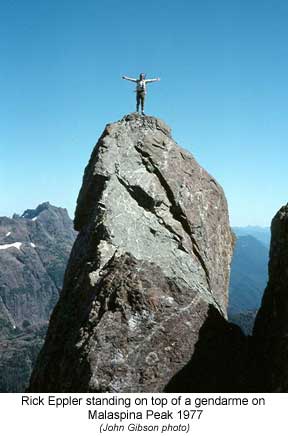 The
first recorded party to attempt Malaspina Peak was on July 10, 1976. John
Gibson, Steve Hinde, Rick Eppler, Gil
Parker, Alan Robinson and Syd
Watts parked their vehicles on the Tahsis Road between Malaspina
Lake and Perry Lake and headed off into an area that had been previously
logged. After three hundred feet they crossed a small valley and reached
the Northwest Ridge of the mountain. The ridge rose steadily and according
to John Gibson there were no difficulties avoiding the bluffs. Game trails
were good and the bush was not as thick as they expected being so close
to the west coast although they got slightly wet in the huckleberries.
Eventually they emerged from the timber onto an open snow covered ridge
at 3,500 feet and followed the ridge towards the south peak. Roping up
they traversed left up fairly steep snow to a col between the south and
main summits. The main peak was hidden by cloud and separated from them
by "some rather fearsome looking gendarmes." Consequently, the
route to the main peak looked a bit complex for such misty conditions
and they decided to settle for the south summit which looked more approachable
with a straight forward snow ridge leading to it from the col. Upon reaching
the mist shrouded summit around 2:00 p.m. they found a substantial cairn
adorning it with no indication of who had built it. On the way down the
main summit briefly revealed itself through a rift in the clouds and "it
looked a forbidding looking rock tower of impressive verticality."
Later in the day the weather cleared altogether and it looked as though
a traverse around the rock tower would lead to an easier approach to the
main summit from the north.
The
first recorded party to attempt Malaspina Peak was on July 10, 1976. John
Gibson, Steve Hinde, Rick Eppler, Gil
Parker, Alan Robinson and Syd
Watts parked their vehicles on the Tahsis Road between Malaspina
Lake and Perry Lake and headed off into an area that had been previously
logged. After three hundred feet they crossed a small valley and reached
the Northwest Ridge of the mountain. The ridge rose steadily and according
to John Gibson there were no difficulties avoiding the bluffs. Game trails
were good and the bush was not as thick as they expected being so close
to the west coast although they got slightly wet in the huckleberries.
Eventually they emerged from the timber onto an open snow covered ridge
at 3,500 feet and followed the ridge towards the south peak. Roping up
they traversed left up fairly steep snow to a col between the south and
main summits. The main peak was hidden by cloud and separated from them
by "some rather fearsome looking gendarmes." Consequently, the
route to the main peak looked a bit complex for such misty conditions
and they decided to settle for the south summit which looked more approachable
with a straight forward snow ridge leading to it from the col. Upon reaching
the mist shrouded summit around 2:00 p.m. they found a substantial cairn
adorning it with no indication of who had built it. On the way down the
main summit briefly revealed itself through a rift in the clouds and "it
looked a forbidding looking rock tower of impressive verticality."
Later in the day the weather cleared altogether and it looked as though
a traverse around the rock tower would lead to an easier approach to the
main summit from the north.
The next year (August 13, 1977) John Gibson, Syd Watts, Alan Robinson and Jim and Geoff Squarok drove back up island on Saturday night and camped beside Malaspina Creek while Rick Eppler arrived at 6:30 a.m. Sunday morning just as they were ready to leave. Syd Watts led them through the bluffs to the Northwest Ridge where they found the basin almost free of snow. After crossing the basin and traversing around to the north they reached a snowfield which took them up to a col between a minor summit to the east and the main summit. Here an easy scramble up the Northeast Ridge led them to the main summit which had eluded them the year previous.
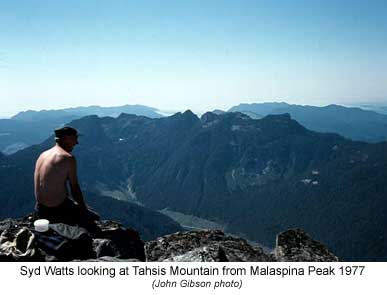 On
October 19, 1997, Sandy Briggs and Charles Turner, two Alpine Club of
Canada members ventured up island and climbed both the south summit and
main summit from a high camp on the Southwest Ridge. On the main summit
they found a note dated October 2, 1993, from "Dave & Dave"
indicating that they had climbed the peak from Canton Creek to the east
of the mountain. The next known ascent was in July 2002 when Paul Rydeen
and Darren Wilman, from The Heathens Mountaineering Club in Campbell River,
climbed the peak from logging roads that left the West Canton Main and
wound up onto the south ridge of the mountain.
On
October 19, 1997, Sandy Briggs and Charles Turner, two Alpine Club of
Canada members ventured up island and climbed both the south summit and
main summit from a high camp on the Southwest Ridge. On the main summit
they found a note dated October 2, 1993, from "Dave & Dave"
indicating that they had climbed the peak from Canton Creek to the east
of the mountain. The next known ascent was in July 2002 when Paul Rydeen
and Darren Wilman, from The Heathens Mountaineering Club in Campbell River,
climbed the peak from logging roads that left the West Canton Main and
wound up onto the south ridge of the mountain.
Finally, on July 5, 2006, Lindsay Elms and Valerie Wootton climbed Malaspina Peak from the head of Canton Creek via a snow gully that went virtually all the way from the valley floor to the summit ridge. After reaching the ridge the minor east summit was climbed and some tricky moves were made to reach a small col below the main peak. It was then an easy scramble to the top, however, on the descent an easy route was found that by passed the rock step and the easy snow gully was reached for the return to the Canton Creek.
Today names from the Spaniards who visited the west coast of Vancouver Island during that turbulent period of the 1790's decorate various physical features reminding the historians of the fact that Spain and Britain almost come head to head in battle over Nootka Sound. Although times have changed, some climbers consider that they come to do battle with the bush and mountains on the island's west coast. Malaspina Peak is another one of those peaks that challenges the mountaineer who is prepared for the long drive up and across the island to take advantage of small windows of opportunity with the weather to tread its summit.
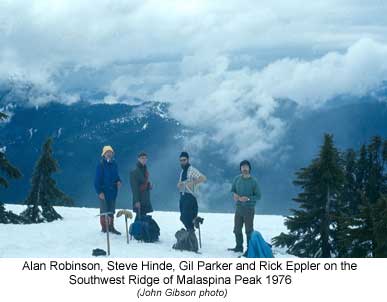 |
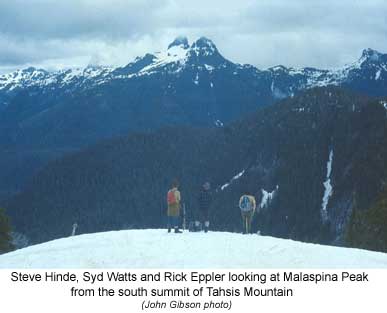 |
|
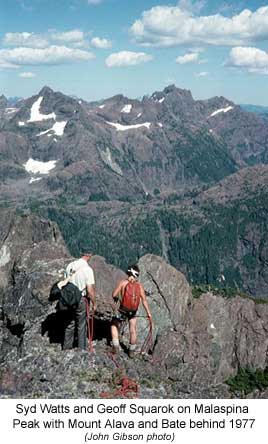 |
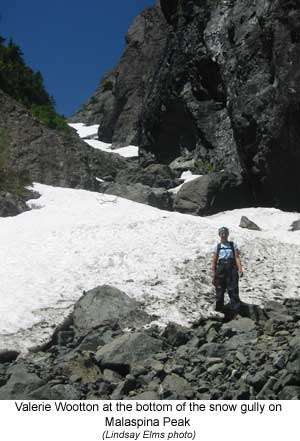 |
How to order | | About the Author || Links || Home
Contact:
Copyright ©
Lindsay Elms 2001. All Rights Reserved.
URL: http://www.beyondnootka.com
http://www.lindsayelms.ca